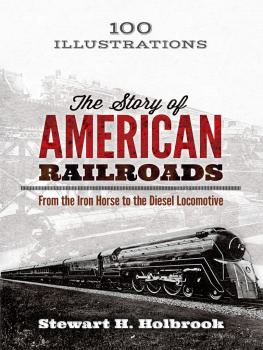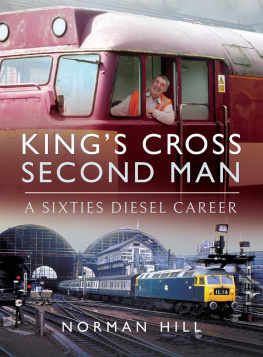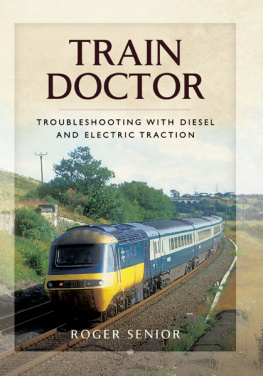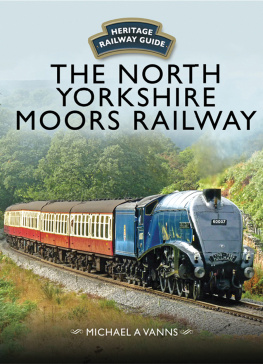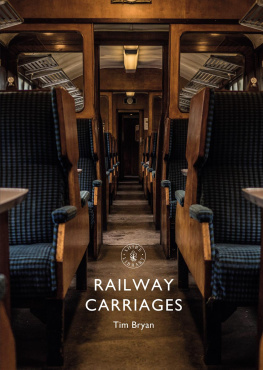The Story of
AMERICAN
RAILROADS

From the Iron Horse to the Diesel Locomotive

Stewart H. Holbrook
DOVER PUBLICATIONS, INC.
Mineola, New York
Copyright
Copyright 1947 by Stewart H. Holbrook
Copyright Renewed 1974 by Sibyl Holbrook
All rights reserved.
Bibliographical Note
This Dover edition, first published in 2015, is an unabridged republication of the work originally published by Bonanza Books, New York, in 1947.
Library of Congress Cataloging-in-Publication Data
Names: Holbrook, Stewart H., 18931964, author.
Title: The story of American railroads : from the Iron horse to the Diesel locomotive / Stewart H. Holbrook.
Description: Mineola, New York : Dover Publications, Inc., [2016] | ?1947. | This Dover edition, first published in 2015, is an unabridged republication of the work originally published by Bonanza Books, New York, in 1947. | Includes bibliographical references and index.
Identifiers: LCCN 2015024216| ISBN 9780486799223 | ISBN 0486799220
Subjects: LCSH: RailroadsUnited StatesHistory.
Classification: LCC HE2751 .H44 2016 | DDC 385.0973dc23 LC record available at http://lccn.loc.gov/2015024216
Manufactured in the United States by RR Donnelley
79922001 2015
www.doverpublications.com
For
MY AUNT JEANETTE
CONTENTS
CHAPTER

ILLUSTRATIONS
Illustrations will be found following pages
ACKNOWLEDGMENT
W HEN I had finished writing this book and reflected on the great number of persons who had given me aid in one form or another, the humbling thought occurred again, as it had before, that a book, no matter who is so bold as to sign it, is more often than not a sort of community, perhaps a national, enterprise. I regret that scores, probably hundreds, of men who aided me in this particular work are not known to me by name. They were the conductors, the brakemen, engineers, firemen, roundhouse men, the baggage masters and news butchers, the station agents and telegraphers with whom I have had occasion to speak, even if briefly, these past forty-odd years. Each of them has contributed something to my laymans casual knowledge of railroads.
Then, there are the railroad men I happen to know, either at first hand or by mail. They are a courteous and freehanded brotherhood, ready to aid, aye, even to cheer on, us outsiders who would write about railroads, although they are quick to damn us, and roundly, should we confuse a mogul and a mikado, or hang the wrong lights on the bobbing end of a train. They are, on the whole, probably more intensely interested in their daily occupation than are the men of any other occupation I could name, offhand or after considerable reflection.
Of these genial persons who have made the way simpler for me I must cite John W. Barriger, Anton Anderson, and Henry B. Willis, all of the Monon Route; O. L. Grisamore, C. E. Kane, and William F. Blye, of the Illinois Central; Donald Ashton and F. T. Darrow(retired), of the Burlington; C. W. Y. Currie, of the New York Central; M. R. Cring, of the Katy Lines; F. H. Johnson, of The Milwaukee Road; R. A. Pearce, of the Alton; I. L. Gordon, of the Reading; George C. Frank and H. L. Skeen, of the Erie; T. J. OShaughnessy, of the Rock Island; Lee Lyles, of the Santa Fe; Wingate Cram, of the Bangor & Aroostook; Thomas E. Owen, of the Louisville & Nashville; Leith Abbott, late of the Southern Pacific; and Forrest O. Hayes, Purdy, Mo., a retired veteran of the Pennsylvania and other lines.
In the allied fields I must also mention the help given by B. D. Westfall, Railway Mail Service; W. A. Scheeder, Parmelee Transfer Company; W. A. Eichhorn, American News Company; Richard H. Johnston, Association of American Railroads; Gardner Stratton(retired), F. W. Colson, and the late Harry Gilbert, employes of Pullman; Harley Hallgren, Consolidated Ticket Office, Portland, Ore.; and Henry B. Comstock, editor of Railroad Magazine, the Old Reliable in its field.
Then there were a number of people, in no wise connected with railroading, who by their special knowledge were able to supply me with information I would otherwise have been hard put to come by, among them Herbert Cox, Eugene, Ore.; Freeman Cleaves, New York World-Telegram; Ernest Haycox, Portland, Ore.; A. H. Holbrook, Colebrook, N. H.; Mrs. Thelma Jones, Wayzata, Minn.; George Jean Nathan, New York City; and George T. Springer, Minneapolis. I might, and do, add that the careful typing of Miss Esther Watson, Vancouver, Wash., rendered the manuscript legible and thus helped to preserve the tempers of editors and typesetters, who often are irritable men.
As always, I am perhaps most in debt to the ladies and gentlemen of the libraries and historical societies, without whom no book of mine would ever have appeared. In respect to the present volume I must thank Charles E. Fisher, Railway & Locomotive Historical Society, Boston; Miss Ruth Porritt, Baker Memorial Library, Cambridge; John G. Weld, The Bostonian Society; Sylvester Vigilante, New York Public Library; Miss Anna Heilmeir, James J. Hill Library, St. Paul; Mrs. Anne McDonnell, Montana State Historical Society, Helena; Miss Eleanor Stephens, State Librarian, Salem, Ore.; Miss Nell Unger, Miss Katherine Anderson, Miss Louise Prichard, and Miss Nellie Fisher, all of the Portland (Ore.) Public library; Miss Barbara Gantz, Reed College Library, Portland; Chapin Foster, Washington State Historical Society, Tacoma; and the Pacific Northwest Bibliographic Center at the University of Washington, one of the unsung glories of the region where I make my home.
I owe much for extending every facility of his group to Robert S. Henry of the Association of American Railroads, who also went far beyond the limits of mere courtesy to make my way easier.
Thanks are due to Milton L. Bernstein, Chairman of the Museum Committee of The Railroadians of America, from whose unique collection the majority of the old prints among the illustrations were taken.
Finally, to Freeman H. Hubbard, good friend, long-time editor of Railroad Magazine, and now free-lancing with the fine Railroad Avenue already to his credit, I must tender special thanks. Mr. Hubbard gave most freely of his time and of his wide knowledge to advise me, and then not only made available his superb collection of railroadiana but also supervised the collecting and arranging of the illustrations.
Listed in the Bibliography are the works that the author found of particular help.
CHAPTER I
Panorama
F OR a time in my boyhood I lived on a farm within sound of the Grand Trunk Railway, and went to school in the town of North Stratford, a junction with the Maine Central. The Grand Trunk was not the first railroad I can remember, but it was the one that appealed most powerfully to me, that stirred my imagination beyond compare. Not before and surely never since have I heard the like of the whistle of a Grand Trunk mogul as it moaned up from deep in the forest we called the Hegan Woods and came wafting on frosty waves through the brittle air of a December in northern Vermont.
To me those moguls were gigantic locomotives. I firmly believed them to be the largest locomotives on earth, and so did all other boys of the town. They hauled the long freights between Portland and Montreal, and commonly stopped at North Stratford for water. There, on a grade crossing in the very center of the village, one of them stood at dusk every winter night, holding up what town traffic there was while we boys stood to watch the great black monster with its trimmings of ice that told of bitter weather, and listen fascinated to its breathing.
Next page
